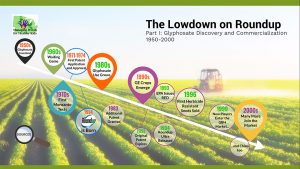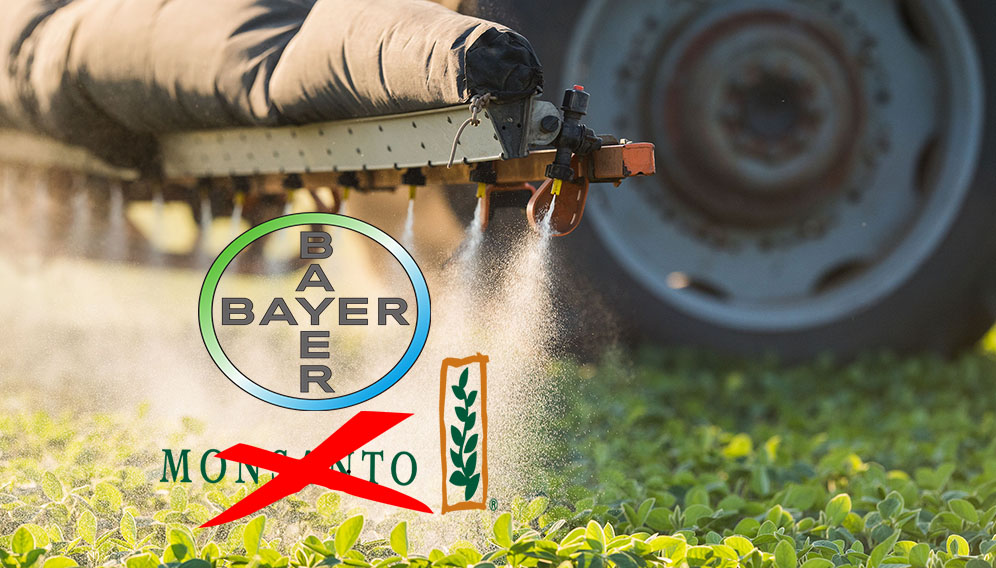On Thursday, June 7, 2018, Bayer’s $66 billion purchase of Monsanto will close, and the world’s most powerful pesticide, seed, and ag biotechnology company will be born. Within months, according to Bayer’s CEO, the Monsanto name will be dropped, and for good reasons.
This is very big news in the world of big ag. News stories covered the upcoming change extensively, including the Washington Post, NPR, and Bloomberg. Perhaps CBS sums it up the best in their story title- “As Bayer Monsanto merger closes, a toxic corporate name to be retired.”
Some people are excited about what the new Bayer will be able to accomplish in bringing “modern agriculture” to small-scale farmers worldwide.
Others are worried for basically the same reason, given that “modern agriculture” is code for more intensive, specialized, chemical-dependent, large-scale, and GE-based farming systems.

Such systems do not lend a hand to small-scale farmers working to increase production and income so their children can go to school. Cash intensive, large-scale systems create new agrarian elites who use their economic and political clout to take over small-holder farms, turning former owners and stewards into either low-wage workers, or new migrants to cities and urban areas.
In both developed and developing nations, including many where one-half or more of the population are subsistence farmers, Monsanto-style “modern agriculture” and the initial, new-Bayer product line will lead to an incrementally larger share of each crop dollar earned going to the technology providers and agricultural input industries, and incrementally less staying on the farm.
Just ask any large-scale Midwest corn and soybean farmer how they feel about their seed plus pesticide expenditures relative to expected gross income in crop year 2018 compared, say, to 20 years ago.
Sure, “modern agriculture” and the new-Bayer product line has made it much easier for one farmer to cover three or four-times more acres than they were able to manage in 1998, but are they really better off? And how about their neighbors, small towns, and the planet?
The Global Dominance of the New Bayer
I have tracked the corporate growth, product portfolio, investment priorities, and commitment to product stewardship and human health in Bayer and Monsanto over the last 40 years, and I will watch with interest the path the new Bayer chooses to pursue.
Bayer brought into the world in the early 1990s what soon became, and remains, the most widely used class of insecticides, the neonicotinoids (for more, see this excellent neonic review paper).
The ecological and public health impacts of neonics are now of great concern worldwide, and the European Union is phasing out almost all uses of three of the most widely used neonics because of serious impacts on invertebrate biodiversity, coupled with acute, adverse impacts on pollinators. Native insect populations in the U.S. are also in decline in high-neonic use areas.
Monsanto brought glyphosate, and its Roundup brand herbicides onto the market in 1974.

By 2010, glyphosate-based herbicides (GBHs), led by dozens of Monsanto’s Roundup brands, came to dominate the global herbicide market. Today, GBHs are, by a factor of about three, the most widely used pesticide in history, both in the U.S. and globally.
Enough GBH will be applied in 2018 to spray about two-thirds of a pound of pure glyphosate on every acre of harvested cropland on the planet, and about ¾ of a pound/acre on all harvested cropland in the U.S. (click here for the detailed calculations and data sources, or see our Lowdown on Roundup Part III).
So, the new Bayer will be responsible, going forward, for winding down the well-documented risks stemming from the very heavy use of the world’s leading family of insecticides, AND the world’s leading herbicide.
In addition, the new Bayer will control around three-quarters of the commercially important genetically engineered (GE) crop technologies that are now part of the vast majority of the world’s supply of corn, soybean, cotton, sugar beet, and alfalfa seed.
The new Bayer will pick up the sword – and playbook – that Monsanto has used so effectively around the world. Monsanto-style PR and “public engagement” has been used to advocate for GE crops, defend glyphosate, attack the International Agency for Research on Cancer, and bend the will of regulators to support the company’s view of pesticide and GE crop benefits and risks. Pretty effectively too, judging by the massive growth in glyphosate use and widespread planting of GE crops, not to mention the company’s healthy profit margins.
The New Bayer Acid Test

For those working to encourage Bayer to make a clean break from the corporate behavior, marketing and stewardship policies, and ethics of Monsanto, here are nine concrete actions that the new Bayer could announce and implement in the next few months to show today’s skeptics that the new Bayer is not going to become the old Monsanto on steroids.
About half of the below steps fall safely in the no-brainer zone. The new Bayer will not need much time to reflect on their merits nor ponder how to implement them. They will either do them, or they will not, and we will know soon which it will be.
- The new Bayer will phase out globally pre-harvest, desiccation uses of Roundup and other GBHs, a huge benefit to consumers. New Bayer can do this because they will, in effect, control all GBH tolerances and most registrations allowing such uses (if you need a refresher on pesticide regulatory thresholds, see our Lowdown on Roundup Part II). If new Bayer bails on these uses, all companies will have to follow suit.
- The new Bayer will place mandatory weed resistance management provisions on all glyphosate-based herbicide labels, starting with the requirement that a GBH can be applied in no more than 2 out of 3 years on any farm field.
- The new Bayer will commit to fund independent monitoring of the spread of GLY-resistant weeds, and will pledge to quickly augment weed resistant management requirements in any region/county in which resistant weeds continue to emerge and spread. In such areas, amended labels will allow a GBH to be applied in only 1 of every 3 years on all fields.
- The new Bayer will pledge, and follow through in adding weed resistance management requirements on all 2,4-D and dicamba herbicide labels, and incorporate stringent resistance management requirements in all GE seed “Technology Use Agreements” signed annually by farmers.
- The new Bayer will cooperate with regulators worldwide (rather than bully them) to add common-sense worker protection requirements on all its pesticide labels, including over a dozen requirements that the U.S. EPA called upon Monsanto to add to dozens of glyphosate labels by 1989, but still have not been added to any Roundup label in the U.S.
- The new Bayer will: (a) stop systemic harassment of academic and other non-industry scientists wanting to conduct independent research and willing to speak openly about their findings, even when the findings are not aligned with the company’s view of reality, and (b) be fully transparent (and honest) about who, and what science they’re funding or otherwise influencing (e.g. Kevin Folta), and what seemingly independent research they are controlling in one, or several ways (e.g. Monsanto’s long and rich history of ghost-writing op-eds and peer-reviewed journal articles).
- The new Bayer will pledge to abide by any worker-safety requirements and restrictions on neonics and glyphosate imposed in the EU in ALL markets worldwide.
- The new Bayer will agree to not field test or commercialize gene editing technologies and gene drives without full assessment of the technologies by independent scientists, coupled with open, rigorous government oversight and widespread input from those impacted by, or concerned over the consequences of these emerging technologies.
- And last, the new Bayer will pledge to not field test or commercialize genetic engineering technology that renders seeds sterile, as well as any analogous technology developed to alter the DNA of animals.
The new Bayer has pledged to listen to stakeholders and its customers regarding the new paths the company will follow.
Hopefully some of the above, simple, concrete actions will make the list of reasons why the public, farmers, and governments should give the new Bayer time to prove it understands the essential goals and attributes that “modern ag” systems and technology need to embrace.
Sources:
Caitlin Dewey, “Why ‘Monsanto’ is no more,” Washington Post, June 4, 2018.
Camila Domonoske, “Monsanto No More: Agri-Chemical Giant’s Name Dropped In Bayer Acquisition,” NPR, June 4, 2018.
Kate Gibson, “As Bayer Monsanto merger closes, a toxic corporate name to be retired,” CBS News, June 5, 2018.



Nice summary of several of the important problems caused by Monsanto and Bayer, although expecting them to take actions that will reduce their collective bottom lines does not seem realistic. Monsanto, as you note, has engaged in many harmful activities beyond simply developing its products. But so has Bayer, defending past all scientific reason its sales of neonicotinoids. So I will not hold my breath waiting for them to act on your suggestions. It will take public action to move past the industrial ag that Monsanto and Bayer support and thrive on, not reliance on the companies. But as a rhetorical device at least, it is good to have your list.
However, several important actions regarding neonics should be added. One of the most important is to stop pretreating crop seed with those insecticides. Corn in particular can be very hard for farmers to buy in untreated form, contributing to massive overuse. And research has clearly shown that the very large majority of those seed treatments are not needed to protect those crops. See my recent article for more on this: https://civileats.com/2018/03/28/new-science-shows-bee-killing-pesticides-are-unnecessary-on-most-farms/
Excellent post! Anti-trust regulators have failed again to rein in oligopoly power (despite boasting about required divestments). Thanks for a great start on the the long list of potential concrete actions that the New Bayer must pledge to adopt.
Doug and Hope, apologies for not noticing you had both shared these comments via Hygeia. Thanks for weighing in.
Doug, do you feel a case can be made for a ban on all neonic corn+soybean seed treatments, or do you feel they are some circumstances when targeted use might justify the hit on pollinators? If so, what circumstances?
Hope, you and I have discussed many times the reasons and ways BASF will emerge from the industry’s merger mania with the most improved product line, lowest debt, and numbers Wall Street will love. Why has so little attention been focused on how much bigger and more powerful BASF is becoming?
Chuck, the short answer to your question is that there are viable alternatives to seed treatments. In particular, the process of pre-treating months in advance, and rarely in response to scouting or any other actual assessment of pests, is completely contrary to IPM practices that almost all academic entomologists support (even those that generally support industrial ag).
A more detailed response would require looking at particular pest insects. I did that in long report published a year ago, relying on extensive analysis of the research literature. The report has been favorably received by entomologists who work on neonic problems and alternatives. The report discusses the prevalence of the target pests and practices that avoid them. For anyone who wants those details, the report can be found at: https://www.centerforfoodsafety.org/files/alternatives-to-neonics_v9_23186.pdf
Of course, any method or growing crops and controlling pests can occasionally fail. The answer to this is not, to my mind, the overuse pesticides in anticipation that this might occasionally happen, but rather social and policy mechanisms to compensate for those unusual occasions. For example, insurance is preferable to pesticide use. It was estimated that a farmer supported insurance program in Europe instead of neonic seed treatments would cost farmers only about 10% of what they currently pay for seed treatments. That’s because the use of that insurance would rare, because these secondary pests are actually uncommon.